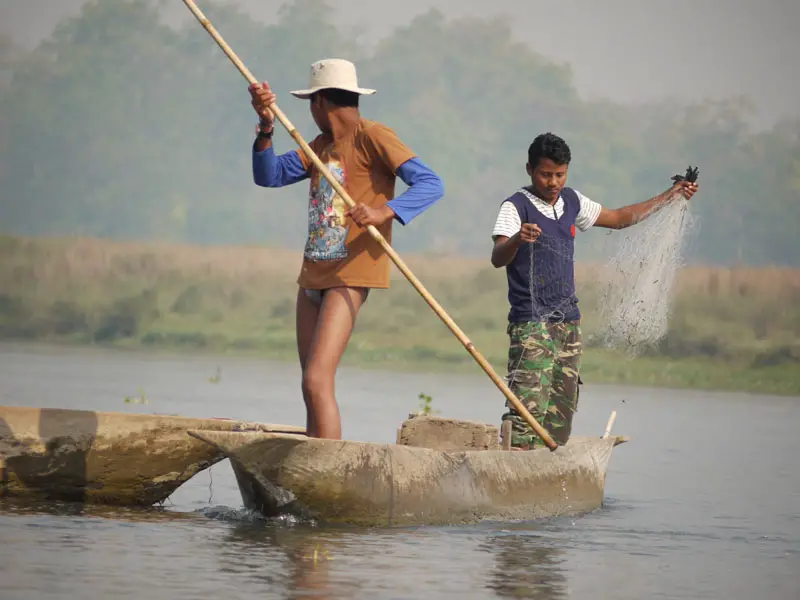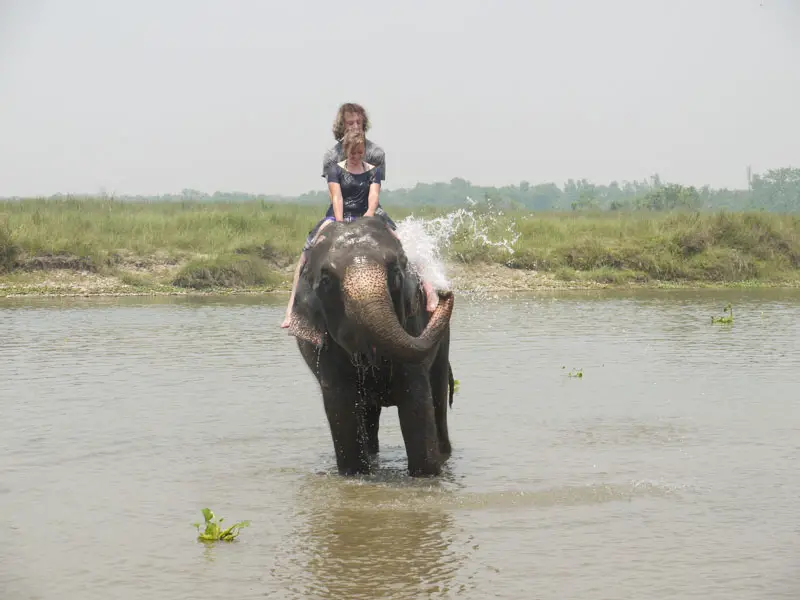Having originally planned to visit Bardia National Park in the Western Terrai, it proved too expensive when we looked at it more closely and so instead we decided to visit the much more touristy but much less expensive Chitwan National Park. We spent an afternoon in Pokhara walking in and out of travel agents offices trying to find the best way to tackle it and in the end, against our better judgement we booked a package tour for three days and two nights to the Chitwan National Park in the Terrai.
Our package included transfers from our guesthouse door to our accommodation in Sauraha, just outside the park and it went off without a hitch. We arrived at Hotel Rainforest in Sauraha just in time for lunch and after a quick briefing from our guide Budda, we tucked into some much-needed lunch. The room at the hotel was a cut above what our budget usually allows and after a quick stroll around town in the midday heat, it was a pleasure to come back to our cool, fancy room.
Our program began with a sightseeing walk around town. Budda pointed out the Tharu villages and explained how their homes were constructed with reed which were then plastered with a mixture of clay and cow dung. The Tharu people are locals to the Terrai region and are an agricultural people due mainly to the flat plains of the Terrai which are so different compared with the mountainous landscape of most of Nepal.
We continued onto the elephant ‘stables’ where tusked Asian elephants were kept in their accommodations for the evening with a heavy chain attached to one of their front legs. Earlier that day we had seen elephants walking around town with colourful paintings on their trucks. These elephants didn’t have the same colourful markings and although were extremely impressive to see so close up we felt a little sad to see them chained up. Budda explained a little to us about the elephants and then we walked around by the river to watch the sunset over Chitwan National Park before watching a Tharu cultural show where young locals put on a great show including the impressive Tharu stick dance which got a huge applause from the crowd which had come to watch the spectacle.
The next morning we had an early start for our wildlife spotting trip down the river. The dugout canoe was made from one entire tree trunk and felt a little overloaded with the water only inches from pouring in over the top of the boat. Along the river, we saw a gharial alligator, egret birds, kingfishers, storks and a host of other exotic birds before pulling in to start our walk back to the elephant breeding centre. We weren’t out of the boat a minute and our guide had picked up a rattlesnake skin from the grass. Crossing a sketchy bridge we saw four more gharial alligators basking in the morning sun on a sandspit in the centre of the river. A crocodile poked its snout up from the water too, but didn’t show us any more of itself than that.
We reached the elephant breeding centre without any more sightings and immediately we spotted the tiny elephants in the shelters around the centre. Budda brought us over to a one-month-old baby elephant calf to begin our visit. Next, we were introduced to the twin male elephants, a rare occurrence we were told and the only twin elephants ever to be born in Nepal. Last, Budda led us over to a mother and her two-week-old baby elephant which was learning to eat using its trunk. Cute as this elephant looked, being bigger than a Shetland pony I reckoned it would be surprisingly strong. A visit to the information centre brought us back to the hotel for a quick stop to change into our swimming gear before heading back to the river, not to wrestle crocodiles but for elephant bath time.
Elephant bath time was great fun and not so much a bath for the elephant as it was a shower and a swim for us. One of the staff members at the hotel walked us down to the river where we were told we needed to wait as our elephant was “on the way sir”. A few minutes later our elephant arrived and with a command from the mahout (elephant handler); the elephant lay down and we jumped aboard. Another call from the mahout and the elephant stood up with us on her back and we walked into the river, the elephant being guided by the mahout holding her ear. We spent half an hour being hosed by the elephant, spraying water from its trunk left, right and straight back over her head, encouraged by us in fits of laughter. The mahout brought us out into the middle of the river where the water was a little deeper and a kind of elephant rodeo ensued. The elephant continued to spray us and rolled gently to the right tipping us off the edge of her back into the water over and over. After each fall we climbed back on and relived the experience again and again. I’m not sure if the elephant was finally clean or we were sufficiently wet but bath time was over. We said goodbye and thank you to our elephant and mahout and went back to the hotel for lunch and a rest before our elephant themed afternoon continued.
Walking up the stairs to the wooden platform we were excited at the prospect of seeing tigers, sloth bears, wild deer, wild elephants and one horn rhinos in the jungle. We climbed onto the seat on the back of the elephant and off we went into the jungle to see what wildlife we would be lucky enough to see.
We weren’t on the elephant very long when we came to an opening in the trees and before us is a marshy pool we saw our first rhino bathing in the pool, about ten feet in front from the rhino the back of a crocodile appeared briefly before disappearing again beneath the murky water. We hung around to take some photos and then the elephant, guided by a short Nepali man sitting on its head, went back into the forest. The Nepali man steered the elephant with his feet, placed behind the elephant’s ears but other than a monkey in the trees high above we didn’t see much wildlife. All of a sudden we came into another opening and there in front of us was a mother and baby rhino. They were amazing to watch grazing and with the tank like armour on their back and around their neck they looked kind of prehistoric. We tracked the rhinos for a while seeing a peacock and wild deer along the way before going back into the forest. Slowly we circled back to our starting point but other than one more large wild deer we didn’t see any more wildlife. We walked back to watch the sunset over Chitwan National Park one last time before we would take the bus back to Pokhara the next morning.
The bus back to Pokhara went though Dumre, the transfer spot for the ridge top village of Bandipur, our next stop. We asked the bus driver to call us when we were at Dumre and took our seats. Driving away from the Terrai we talked about all we had seen and done on our trip to the Chitwan National Park, it had been a great experience. The interaction with the elephants, seeing the rhinos in the wild and spotting alligators were all obvious highlights but the cultural Tharu show, the canoe trip and everything else really made the whole trip something to remember.

Brian is a travel writer, photographer, blogger, travel addict and adventure-junkie. Being outdoors, getting off the beaten track and outside his comfort zone is what makes him tick. Brian’s the dreamer in the relationship; when he’s not travelling, he’s dreaming about it! Keeping fit, cooking, music and red wine take up the rest of his time.
Sign up for our free travel photography Ebook "Faces of Nepal" and you'll also receive our monthly newsletter.












Fortunately, I visited Chitwan national park in 2008 for the first time and the last time as well. Its the place where I had seen Rhino in the jungle for the first time. It was an amazing experience. Thank you for the nice article.